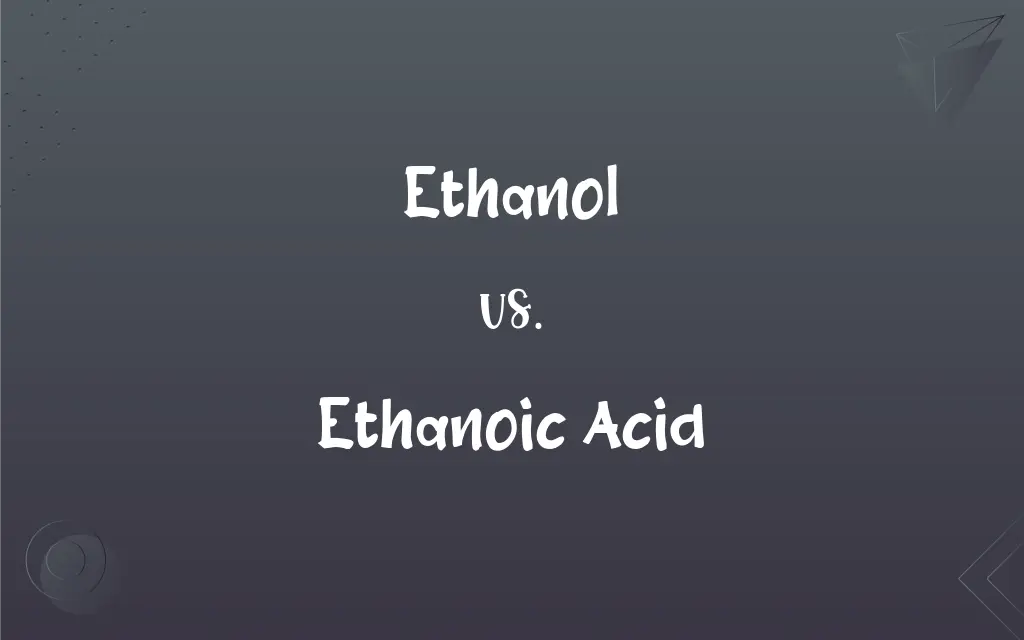Ethanol vs. Ethanoic Acid: What's the Difference?
Edited by Aimie Carlson || By Janet White || Published on February 11, 2024
Ethanol is a volatile, flammable alcohol used as a fuel and solvent, while ethanoic acid is a sour, corrosive organic acid used in vinegar and as a chemical reagent.

Key Differences
Ethanol, commonly known as alcohol, is a clear, colorless liquid with a characteristic odor and is used in beverages, as a solvent, and as fuel. Ethanoic acid, also known as acetic acid, is a colorless liquid with a pungent, vinegar-like smell, used in food as vinegar, and industrially as a chemical reagent. Both are organic compounds but differ in chemical structure and properties.
The chemical formula of ethanol is C2H5OH, consisting of an ethyl group linked to a hydroxyl group, making it an alcohol. Ethanoic acid has the formula CH3COOH, containing a carboxyl group, which makes it an acid. While ethanol acts as a mild depressant to the central nervous system, ethanoic acid exhibits acidic properties and is corrosive.
In terms of usage, ethanol is widely used in alcoholic beverages, as a biofuel, and in thermometers, owing to its low freezing point. Ethanoic acid is used in culinary applications as vinegar, and industrially in the production of plastics, pharmaceuticals, and dyes. Ethanol is notable for its psychoactive effects, whereas ethanoic acid is known for its preservative and antibacterial properties.
Ethanol is produced through the fermentation of sugars by yeast or via petrochemical processes like ethylene hydration. Ethanoic acid is commonly produced by the fermentation of ethanol or from the oxidation of acetaldehyde. The production of ethanol is a key process in brewing and winemaking, while ethanoic acid production is important in food processing and chemical industries.
Safety and handling of ethanol and ethanoic acid also differ. Ethanol is flammable and poses a fire hazard, whereas ethanoic acid can cause skin burns and should be handled with care due to its corrosive nature. Both compounds are biodegradable and relatively less harmful to the environment compared to other industrial chemicals.
ADVERTISEMENT
Comparison Chart
Chemical Structure
C2H5OH (Alcohol)
CH3COOH (Acid)
Properties
Flammable, psychoactive
Corrosive, sour smell
Uses
Beverages, fuel, solvent
Vinegar, chemical reagent
Production
Fermentation of sugars
Fermentation or oxidation of ethanol
Safety
Fire hazard
Skin burns, corrosive
ADVERTISEMENT
Ethanol and Ethanoic Acid Definitions
Ethanol
A renewable fuel source derived from biomass.
Ethanol is produced from corn and used in flex-fuel vehicles.
Ethanoic Acid
A preservative and flavoring agent in foods.
Pickles are often preserved using ethanoic acid.
Ethanol
A solvent used in medical and cosmetic products.
Ethanol is used in hand sanitizers for its antiseptic properties.
Ethanoic Acid
An acid used in the production of plastics and dyes.
Ethanoic acid is a key ingredient in producing vinyl acetate.
Ethanol
A chemical used in thermometers for low freezing point.
Ethanol-filled thermometers are used in cold environments.
Ethanoic Acid
A weak organic acid known for its vinegar-like smell.
Ethanoic acid is the main component of vinegar used in salad dressings.
Ethanol
A volatile liquid alcohol used in beverages and as a biofuel.
Ethanol is added to gasoline to create a more eco-friendly fuel blend.
Ethanoic Acid
A laboratory reagent for acidity tests.
Chemists use ethanoic acid to determine the pH of solutions.
Ethanol
A psychoactive substance found in alcoholic drinks.
Beer and wine contain ethanol, which causes intoxication.
Ethanoic Acid
A chemical reagent used in industrial processes.
Ethanoic acid is utilized in the synthesis of various chemicals.
Ethanol
See alcohol.
Ethanol
(organic compound) A simple aliphatic alcohol formally derived from ethane by replacing one hydrogen atom with a hydroxyl group: CH3-CH2-OH.
Ethanol
Specifically, this alcohol as a fuel.
Ethanol
The organic compound C2H5.OH, the common alcohol which is the intoxicating agent in beer, wine, and other fermented and distilled liquors; called also ethyl alcohol. It is used pure or denatured as a solvent or in medicines and colognes and cleaning solutions, or mixed in gasoline as a fuel for automobiles, and as a rocket fuel (as in the V-2 rocket).
Ethanol
The intoxicating agent in fermented and distilled liquors; used pure or denatured as a solvent or in medicines and colognes and cleaning solutions and rocket fuel; proposed as a renewable clean-burning additive to gasoline
FAQs
Can ethanol be used as a disinfectant?
Yes, ethanol is effective as an antiseptic and disinfectant.
What is ethanoic acid used for?
Ethanoic acid is used as vinegar in foods and as a chemical reagent.
Is ethanol flammable?
Yes, ethanol is highly flammable and used as a fuel.
How is ethanol produced?
Ethanol is mainly produced by fermenting sugars with yeast.
How is ethanoic acid produced?
Ethanoic acid is produced by fermenting ethanol or oxidizing acetaldehyde.
Is ethanoic acid safe to consume?
In dilute form as vinegar, ethanoic acid is safe and widely used in food.
What safety precautions are needed for ethanoic acid?
Handling ethanoic acid requires protective equipment due to its corrosive nature.
What is ethanol?
Ethanol is an alcohol used in beverages, as a biofuel, and a solvent.
What are the physical properties of ethanol?
Ethanol is a colorless, volatile liquid with a distinctive smell.
Is ethanoic acid corrosive?
Yes, in concentrated forms, ethanoic acid is corrosive.
Can ethanoic acid be used in food preservation?
Yes, ethanoic acid is used as a preservative and flavor enhancer in food.
Is ethanoic acid used in medicine?
Ethanoic acid has limited use in medicine, primarily as an acidifying agent.
What is the freezing point of ethanol?
Ethanol has a low freezing point, making it useful in cold-temperature applications.
What is the role of ethanol in alcoholic beverages?
Ethanol is the psychoactive component in alcoholic beverages.
Can ethanol be used in cosmetics?
Yes, ethanol is used in perfumes and cosmetics for its solvent properties.
What industries use ethanol?
The beverage, biofuel, pharmaceutical, and cosmetic industries use ethanol.
Can ethanoic acid be used in plastic production?
Yes, ethanoic acid is used in the production of certain plastics.
What are the environmental impacts of ethanol?
Ethanol is biodegradable and less harmful to the environment than fossil fuels.
Is ethanoic acid biodegradable?
Yes, ethanoic acid is biodegradable and relatively environmentally friendly.
How does ethanoic acid react with bases?
Ethanoic acid reacts with bases to form salts and water.
About Author
Written by
Janet WhiteJanet White has been an esteemed writer and blogger for Difference Wiki. Holding a Master's degree in Science and Medical Journalism from the prestigious Boston University, she has consistently demonstrated her expertise and passion for her field. When she's not immersed in her work, Janet relishes her time exercising, delving into a good book, and cherishing moments with friends and family.
Edited by
Aimie CarlsonAimie Carlson, holding a master's degree in English literature, is a fervent English language enthusiast. She lends her writing talents to Difference Wiki, a prominent website that specializes in comparisons, offering readers insightful analyses that both captivate and inform.







































































